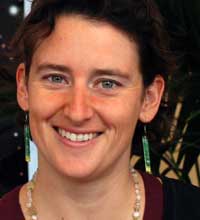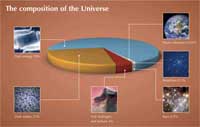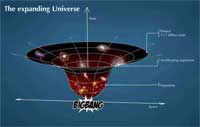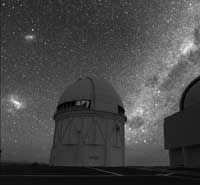“Intelligence is of secondary importance in research” Understand article
Can you play world-class sport, and also be part of a team that tries to understand the nature of our Universe? Yes – just ask Tamara Davis. Henri Boffin from ESO talked to her in Copenhagen, Denmark.

ESO
Ten years ago, a ‘bomb’ exploded in astronomy: because of new observations, the prevailing standard model of the Universe had to be abandoned and replaced by new ideas (see Landua & Rau, 2008, for a discussion of the standard model).
According to the most accepted model of the formation of the Universe, the Big Bang theory, the Universe originated in a very hot and dense state, and has been expanding ever since (as described in Peebles, 2001). Proof of this expansion was provided in 1929 by American astronomer Edwin Hubble, who showed that the speed at which a galaxy moves away from us is proportional to its distance from Earth. This is known as the Hubble law.
The latest observations show that this expansion, instead of decelerating, as one would expect if gravity were the only force present, is currently accelerating. Galaxies are moving away from each other at an ever-increasing rate (see, for example, Leibundgut & Sollerman, 2001).
“Astronomers thus came up with the idea of dark energy, which is the name we give to the mysterious source of the acceleration of the Universe,” says astronomer Tamara Davis. “We do not yet know what it is. It could be a kind of material that has anti-gravity properties, in which case this bizarre stuff would make up over 70% of the energy in our Universe. Or it could be that our theory of gravity might not yet be complete, in the same way as Newton’s theory needed to be extended by Einstein’s theory of general relativity.”

five percent of the
composition of the cosmos –
dark matter and dark energy
are still subject to intense
research. Click on image to
enlarge
Image courtesy of L. Calçada /
ESO
Now that astronomers also have evidence that 25% of the Universe is made of an unknown form of matter (as described in Warmbein, 2007) – dark matter – we only really know about approximately 5% of our Universe. This certainly calls for a degree of modesty!
Tamara works at the Dark Cosmology Centre in Copenhagen, Denmark, and teams up with people from around the world in large collaborations, not unlike those that are now tackling crucial questions in particle physics. Tamara is part of the ESSENCEw1 collaboration, which studies supernovae in order to understand dark energy. She started working on this amazing topic when she moved to the Australian National University and Mount Stromlo Observatory in 2003, after completing her PhD at the University of New South Wales, Australia. “I was extremely lucky to work with a really inspirational scientist, Brian Schmidt, who is one of the researchers who discovered that the expansion of the Universe is accelerating.”
One way to determine the properties of dark energy is to measure distances and velocities of distant light sources so as to calculate how much the Universe expands over time. For this purpose, astronomers observe primarily Type Ia supernovae (as described in Székely & Benedekfi, 2007) – that is, exploding stars. The most distant observed supernovae are so far away that they actually exploded before Earth even formed. Their light has been travelling through space towards us since before our Sun started shining – and remember that, because light moves at a finite speed, looking far away means looking back in time.
Because they are so far away, very little light reaches us, so such observations can only be made with the most powerful of telescopes, such as ESO’sw2 Very Large Telescope (see Pierce-Price, 2006, for a description of working with this telescope), or the Keckw3 and Geminiw4 telescopes – all of which are in remote areas with climatic conditions well suited to telescope observation (almost no clouds, almost no water vapour, and a thin atmosphere). By observing a great number of supernovae spanning a wide range of distances, and measuring their distances and velocities, it is possible to measure how the expansion of the Universe changes with time.

Universe has been expanding
– and with accelerating
speed. Click on image to
enlarge
Image courtesy of L. Calçada /
ESO
The ESSENCE collaboration is a group of about 30 researchers from around the world, who come together to discover distant supernovae so they can be used to understand the acceleration of the Universe and dark energy. Tamara has the daunting task of trying to work out what the measurements of supernovae actually tell us. After she has done her share of the observations, she lets others in the collaboration turn the raw images of supernovae into information about their distance and velocity. Meanwhile, she studies different theories of dark energy and what they predict for the behaviour of the supernovae. When the observations are ready, it is her job to compare the data with the theories and figure out which work best.
“Far and away my favourite part of astronomy is observing at the big telescopes, particularly the ones down in Chile. Using space telescopes [which eliminate the blurring and absorbing effects of Earth’s atmosphere] is also extremely cool, but you don’t get to control the telescope yourself. Actually going up to the telescopes in the Chilean Andes, such as the Very Large Telescope, is amazing. The whole experience of travelling through South America, getting the bus up into some wild, remote part of the desert and then seeing a huge telescope appear on the horizon is like something out of a science fiction film. Then when you are actually there you have a building-size piece of precision machinery obeying your commands. It’s fantastic.”
Tamara not only got hands-on with telescopes in the Chilean Andes – back home in Australia, she used many telescopes, and had some entertaining moments. Once, she was trapped outside the telescope enclosure because a pack of kangaroos was grazing at the gate.

telescope (CTIO Blanco 4-m)
magnificently framed by the
two Magellanic clouds (some
of our nearest galactic
neighbours) on the left and
our own Milky way galaxy on
the right
Image courtesy of Roger Smith
/ NOAO / AURA / NSF
But Tamara also has her eyes on space. In Copenhagen, she is part of a group that is proposing to build a space observatory called SNAP, the SuperNova Acceleration Probew5. SNAP is designed to measure the expansion of the Universe and to determine the nature of the mysterious dark energy that is accelerating this expansion. “I love telling people that part of my job is building a spaceship,” she jokes.
But what is it really all about? “We are trying to understand the fundamental building blocks of our Universe and how the laws of physics work. The kind of advancements in knowledge and in technology that are possible from this work will be truly staggering, although turning this fundamental research into practical applications will take a long time. Current theories don’t explain what this dark energy is, but they are flexible enough to allow it.
“Most exciting to me is that explaining the acceleration of the expansion of the Universe may, according to the most prevalent theories, require a merging of gravity and quantum theory – the physics of the very large with that of the very small. I love the interconnectedness of nature when you realise that the physics of the tiniest particles that make up humans can affect the physics of the entire Universe on the largest scales. Isn’t it mind-blowing?”
According to Tamara and many of her colleagues, the evidence for dark energy is now fairly incontrovertible. “If it was only supernovae that pointed towards such an outlandish idea, it would be easy to suggest that there was just something we had missed in the observations – that somewhere we’d made a mistake. But since the initial discovery, more and more evidence has been piling up from completely different observational tests, and they all require dark energy.”
The cosmic microwave background radiationw6 (the afterglow left over from the Big Bang), observations of galaxy clusters, measurements of baryon acoustic oscillations (the pattern of galaxies in the sky), weak and strong gravitational lensing (for a brief description of gravitational lensing, see Jørgensen, 2006) – these widely varying measurements, which probe very different physics, all agree that the expansion of the Universe cannot be explained without dark energy (see Peebles, 2001).
One would think that following this quest would not leave much time for anything but science. But Tamara’s achievements reach beyond physics. As a PhD student, she served for two years as an elected member of the university sports association executive committee, organising sport for more than 30 000 students. She has competed at national level in no fewer than six sports. She is a ski instructor, gymnastics coach and surf lifesaver.
At the world championships for ultimate frisbee in Germany in 2000, Tamara represented her country for the first time and has since remained an active member of the Australian team, vice-captaining the team to fifth place at the 2004 world championships in Finland. Ultimate frisbee is a team sport played with a frisbee on a rugby field (without the posts). Ultimate frisbee is self-refereed: the players make their own foul calls, so fair play and trust in your opposition is vital. Because of this, the players hold a vote at every tournament as to which team played the fairest. Despite being very competitive, Tamara’s team won the ‘spirit of the game’ award at both world championships, a remarkable achievement.

Image courtesy of Adam
Ginsburg; image source:
Wikimedia Commons
With such a love of and devotion to physics and sport, it is perhaps no surprise that Tamara imagined becoming an astronaut. Unfortunately, if you are not American, this is no easy task, but as Tamara also has Canadian citizenship, she intends to apply if the Canadian Space Agency advertises an opening. In the meantime, as becoming an astronaut seems unlikely, astronomy is the next best thing for her. This decision was influenced by a particularly inspirational high-school physics teacher. “He was an amateur astronomer and bought a small telescope for the school which we could use at night. He also took a couple of us along to an astronomy weekend which was memorable because it was my first exposure to relativity. I was hooked.”
Tamara believes that it does not take much to be good in science – only a natural wonder for the world around oneself and for figuring out how it works. “I’ve learned that intelligence is of secondary importance in research. Interest and inspiration are far more telling signs of whether someone will be successful in a scientific career,” she comments.
Tamara’s interests are not limited to dark energy. Part of her research investigated some fairly daring topics, showing (amongst other things) that the Universe can expand faster than the speed of light, that the speed of light might not be constant, and that the rapid appearance of life on Earth suggests that life in the Universe is common.
She also teaches at university, something she thoroughly enjoys. “I guess it is because I am so excited by what I study that it is completely rewarding to pass on that enthusiasm to others. I love seeing that moment of realisation when someone catches on to a complex concept, or that ‘wow’ moment when they learn something they never knew before.”
References
- Jørgensen, UG (2006) Are there Earth-like planets around other stars? Science in School 2: 11-16.
- Landua R, Rau M (2008) The LHC: a step closer to the Big Bang. Science in School 10: 26-33.
- Leibundgut B, Sollerman J (2001) A cosmological surprise: the Universe accelerates. Europhysics News 32(4): 4. www.eso.org/~bleibund/papers/EPN/epn.html
- Levin J (2003) How the Universe Got Its Spots: Diary of a Finite Time in a Finite Space. New York, NY, USA: Anchor Books
- Peebles J (2001) Making sense of modern cosmology. Scientific American 284: 44. www.sciam.com/article.cfm?id=making-sense-of-modern-co
- Pierce-Price D (2006) Running one of the world’s largest telescopes. Science in School 1: 56-60.
- Székely P, Benedekfi O (2007) Fusion in the Universe: when a giant star dies…. Science in School 6: 64-68.
- Warmbein B (2007) Making dark matter a little brighter. Science in School 5: 78-80.
Web References
- w1 – For more information about the ESSENCE (Equation of State: SupErNovae trace Cosmic Expansion) collaboration to find supernovae distributed evenly over the redshift range, see: www.ctio.noao.edu/wproject
- w2 – For more information about ESO (the European Southern Observatory) and its educational projects, visit: www.eso.org/outreach/eduoff
- w3 – The website of the Keck Observatory in Hawaii, USA: www.keckobservatory.org
- w4 – The website of the Gemini Observatory: www.gemini.edu
- w5 – The SNAP website: http://snap.lbl.gov
- w6 – The Wilkinson Microwave Anisotropy Probe (WMAP) is a NASA Explorer mission producing a wealth of precise and accurate cosmological information. WMAP produced the first full-sky map of the microwave sky. WMAP measures cosmic microwave background radiation – the light left over from the Big Bang, shifted to microwave wavelengths due to the expansion of the Universe. For more information about WMAP, see: http://map.gsfc.nasa.gov
Resources
- For more information about Tamara and her work, see her webpage: www.dark-cosmology.dk/~tamarad/index.html
Institutions
Review
Two topics tend to inspire teenagers to study physics: the fundamental questions relating to how the Universe got its spots (such as Levin, 2003), and astronomy. Neither topic is found in standard secondary-school curricula, but this article contains a bit of both. Students are likely to find it very interesting that the study of supernovae using telescopes can help prove (or disprove) the standard model of cosmology.
In addition, many non-scientists – secondary-school students included – still imagine physicists to be skinny male nerds on the autistic side of normal, or bearded and bespectacled nutters (or, in the unlikely event that they’re female, distinctly weird spinsters with no life outside the lab) who work in isolation, never seeing the light of day. A description of a real physicist, whom students might wish to meet, work with, or even emulate, is welcome. Moreover, the job that Tamara does, which requires international collaboration, travel to exotic locations and playing with mega toys, might well persuade students that a career in physics could be seriously interesting, maybe even exciting or fun.
Teachers could use this article to stimulate a discussion of:
- How science advances through experiment, and how ideas change and theories have to be modified (Copernicus, Newton, Einstein…)
- The role of central facilities and international collaborations
- The use of space telescopes to eliminate atmospheric interference in astronomy
- Things we still don’t know or understand properly
- The value (or otherwise) of doing this kind of fundamental work
- Stereotypes, caricatures and preconceived ideas.
It could also be used for enrichment when studying light scattering in the atmosphere, or as a basis for student research into how physicists determine the distance to stars or how stars move with respect to Earth.
Collaboration with the art department might lead to some interesting representations of supernovae, and imaginations could be stretched even further by thinking about what the Universe may have looked like when a very distant supernova exploded.
Finally, children might calculate how far the light from a distant supernova was from Earth at the time that Earth was formed, or when dinosaurs roamed Earth, giving their answers (for example) in multiples of the distance to Alpha Centauri.
Halina Stanley, France





